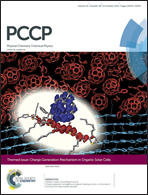Multiple-state interfacial electron injection competes with excited state relaxation and de-excitation to determine external quantum efficiencies of organic dye-sensitized solar cells†
Abstract
A comprehensive description of the complicated dynamics of excited state evolution and charge transfer at the photochemical interface in dye-sensitized solar cells is crucial to understand the mechanism of converting solar photons to clean electricity, providing an informative basis for the future development of advanced organic materials. By selecting two triarylamine-based organic donor–acceptor dyes characteristic of the respective benzoic acid and cyanoacrylic acid anchors, in this paper we reveal stepwise excited state relaxations and multiple-state electron injections at a realistic titania/dye/electrolyte interface based upon ultrafast spectroscopic measurements and theoretical simulations. Density functional theory (DFT) and time-dependent DFT calculations show that the optically generated “hot” excited state of the dye molecules can undergo a significant conformational relaxation via multistage torsional motions, and thereby transform into an equilibrium quinonoid structure characteristic of a more planar conjugated backbone. A set of kinetic parameters derived from the target analysis of femtosecond transient absorption spectra have been utilized to estimate the electron injection yield, which is in good accord with the maximum of external quantum efficiencies.


 Please wait while we load your content...
Please wait while we load your content...